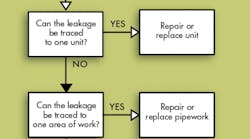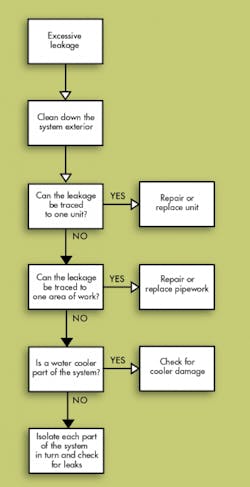Eliminating – or at least reducing – leakage should be a cooperative project between a company’s management and its maintenance department.
There are two types of leakage: external and internal. Because internal leakage (inside components) is a complex topic all its own, this discussion is limited to troubleshooting external leakage. Monitoring external leakage is fairly easy, Figure 9; stopping it is not difficult; but preventing its recurrence may be a challenge.
Tapered threads
All other factors notwithstanding, the single and by far greatest contributor to external leakage is the tapered pipe thread. When components with pipe threads are assembled, the threads leave a space shaped like a conical helix. This helix is a ready-made leakage path. Various methods have been used to eliminate this leakage path – mechanically crushing the threads, using sealing tapes or other sealant materials – but results are not always satisfactory, particularly when connections must be opened and remade. The solution is not to use NPT threads at all. Substitute straight thread connections that are leak-free.
Technical and professional societies continue to emphasize the need to get rid of NPT plumbing. Unfortunately, many manufacturers are still using this outmoded technique. On the positive side, specifications calling for the elimination of NPT plumbing are beginning to filter down from large OEMs, including the automotive and primary metals industries and others.
Other companies that buy and operate hydraulic equipment should involve themselves in this situation by only considering machinery with straight thread connections. While these connections may add slightly to original equipment prices, they will pay for themselves in the long run – often in money saved just by not having to add make-up fluid to the system. If users elect not to specify straight thread connection, they must resign themselves to living with leakage and paying for it.
Other causes
Many other conditions can cause external leakage. Vibration that can loosen connections is obviously a major culprit. In addition, the troubleshooter should consider the possibility of improper plumbing assembly, where fittings were not tightened properly in the first place.
Damaged or worn seals (in linear as well as rotary components) are a common cause of leakage. While replacing defective seals, the troubleshooter should also consider steps that might be taken to eliminate – or at least minimize – seal leakage in the future. For instance, are seals made of the appropriate elastomers? Might a different seal design reduce leakage? Should cylinder rods be specified with different surface finishes? Would boots help extend seal life and thus reduce leakage?
Such thoughts should be communicated to the company’s own top management which should review these factors in the future when the company plans to buy additional manufacturing machinery. Good planning before purchasing might help eliminate the necessity for a lot of troubleshooting!


